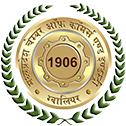Gwalior, the city with a celebrated history, is the tourism capital of Madhya Pradesh. From massive forts to beautiful temples and stunning monuments, the city has a galore of attractions to delight travelers. That’s not all! Gwalior has given the most talented musicians to our country. It was in this city where Tansen learned his art and created many Ragas and Dhrupad compositions, strengthening the foundation of Indian classical music. The cultural and historical significance of Gwalior cannot be described in words. You must visit the city to understand the importance of its contribution to our country’s rich heritage and culture.
Places to visit in Gwalior:
1. Gwalior Fort, Gwalior
Known as ‘the pearl amongst fortresses in India’, the impenetrable Gwalior Fort has witnessed many wars and events. Standing tall atop a rocky mountain, this architectural marvel spreads over an area of 3 sq. km and is visible from all the corners of the city. There are several attractions inside the fort including palaces, temples and water tanks, and it might take almost a day to explore the place.
- Timings: 06:00 am – 05:30 pm
- Entry Fee: ₹ 75 for Indians; ₹ 250 for Foreign Tourists

2. Phool Bagh, Gwalior
The late Madho Rao Scindia built Phool Bagh, and it was inaugurated by the Prince of Wales in 1922. A museum and a residential palace; this site encompasses a gurudwara, a temple, a mosque, and the city zoo in its campus. The place is famous for well-maintained and beautiful gardens, where you can enjoy a picnic or spend time with family and loved ones.
- Timings: 05:30 am – 07:00 pm
- Entry Fee: Free
3. Gujari Mahal Museum, Gwalior
Built by Raja Man Singh Tomar, this 15th-century palace museum is located inside the Gwalior Fort. Gone through the test of time, this archaeological museum will give you an insight into the history of the city and its rulers. The rare collection of sculptures displayed here are a highlight of the museum. You will also see terracotta items, stone & copper plate inscriptions, coins, bronze sculptures, arms and weapons, replicas of Bagh Cave paintings and excavated material in its exhibits.
- Timings: 09:00 am – 05:00 pm (Closed on Monday)
- Entry Fee: ₹ 10 for Indians, ₹ 100 for Foreign Tourists
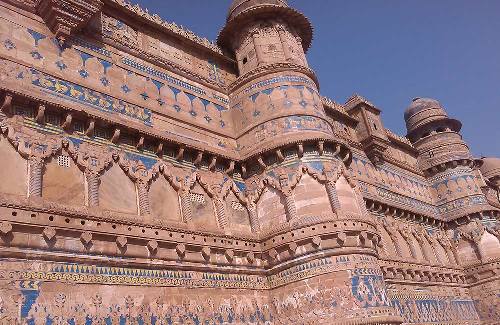
4. Sarafa Bazar, Gwalior
From jewelry to handicrafts and textiles, Sarafa Bazar is a must-visit place for shopaholics. It is one of the oldest and the most famous markets in Gwalior. You can buy lacquer work, chanderi silk, home décor, handmade carpets and vases with intricate designs here, at unbelievable prices. Don’t forget to try pani puri and other lip-smacking street food at the market.
- Timings: 10:00 am – 10:00 pm
- Entry Fee: Free
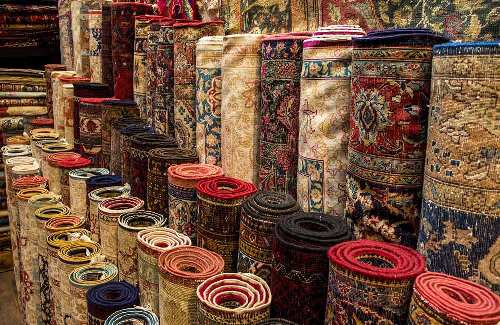
5. Teli Ka Mandir, Gwalior
An ancient religious site famous for its Dravidian architecture and detailed artwork, Teli Ka Mandir is the tallest structure inside the Gwalior Fort complex. It is around 100 ft. tall, and the architecture is a blend of Buddhist and Hindu styles. According to historians, this temple was constructed during the 8th or 11th century and is the oldest temple in the fort. It is devoted to Lord Vishnu in the form of his mount ‘Garuda’ and also has structures of coiled serpents and river goddesses inside.
- Timings: 08:00 am – 06:00 pm
- Entry Fee: ₹ 20
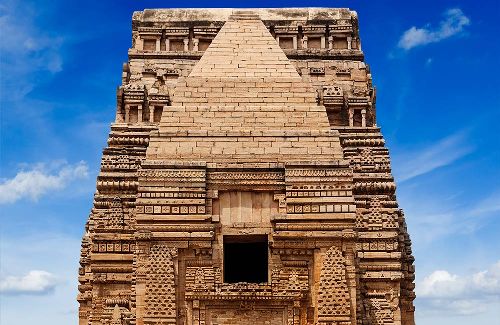
6. Gwalior Zoo, Gwalior
Gwalior Zoo is a must-visit place for wildlife lovers and a great place to spend the weekend with kids and family. The zoological park was built by the royal family in the year 1922 and is spread in an area of 8 hectares. It is home to various rare animal species including a white tiger and others like hyena, golden pheasant, black buck, bison and spotted deer.
- Timings: 08:00 am – 06:00 pm (Closed on Friday)
- Entry Fee: ₹ 20 per Adult; ₹ 5 per Child

7. Samadhi of Rani Laxmi Bai, Gwalior
The brave warrior Rani Laxmi Bai was an inspiration during India’s struggle for freedom. To celebrate her fierceness and pay homage to her sacrifice, an eight-meter tall metal statue of hers is installed in the heart of Phool Bagh. Every year in June, a fair is organized at the Samadhi of Rani Laxmi Bai.
- Timings: 24 hours
- Entry Fee: Free
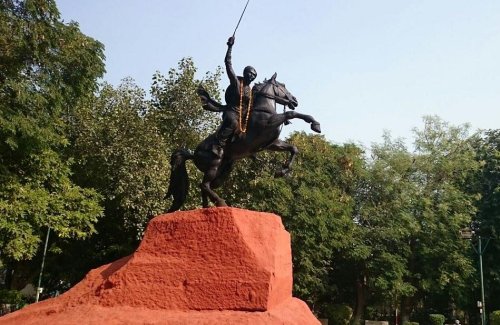
8. Moti Mahal, Gwalior
One of the most historic buildings in the city, the 19th-century Moti Mahal has some beautiful gardens and fountains within its premises. It was once the office of Madhya Bharat Government and has now been converted into offices of the State Government. The beautiful tempera colors, wall paintings and mosaic work depicting Ragas and Raginis are the highlights of this palace.
- Timings: 10:00 am – 10:00 pm (Closed on Sunday)
- Entry Fee: Free
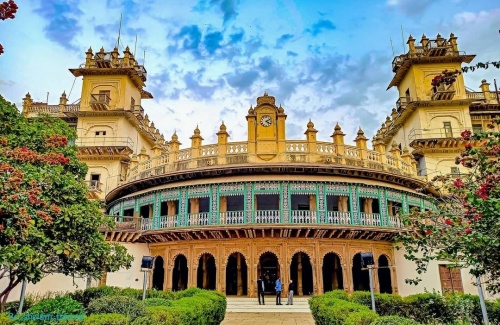
9. Jai Vilas Palace, Gwalior
Only 650 meters from Moti Mahal, Jai Vilas Palace is a grand structure built by Jayaji Rao Scindia in 1874. The building has European style architecture and is quite famous for its Durbar Hall, which is adorned with some of the grandest chandeliers in the world and a huge carpet that took nearly 12 years to weave. The rooms in the palace have been converted into a museum, and exhibit furniture, paintings, sculptures, decorative art, textiles and more collected by the royal family.
- Timings:
10:00 am – 04:45 pm (April – September)
10:00 am – 04:30 pm (October – March) - Entry Fee: ₹ 140 for Indians, ₹ 800 for Foreign Tourists
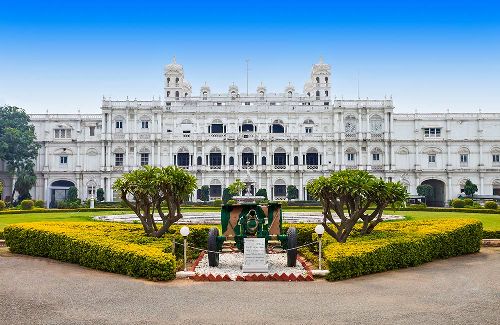
10. Amma Maharaj ki Chathri, Gwalior
Amma Maharaj ki Chathri is just a kilometer from Jai Vilas Palace and is popular for the cenotaph of Late Madho Rao Scindia. If you are looking for some peace and solace, you will be in love with the beautiful, lush green gardens here.
- Timings: 01:00 pm – 05:30 pm
11. Tomb of Muhammad Ghaus, Gwalior
Muhammad Ghaus was a 16th-century Sufi Saint, who was an advisor to King Babur and teacher of music maestro Tansen. His tomb has hexagonal pavilions and stone carvings depicting the elegance of Mughal architecture.
- Timings: 06:00 am – 06:00 pm
- Entry Fee: Free
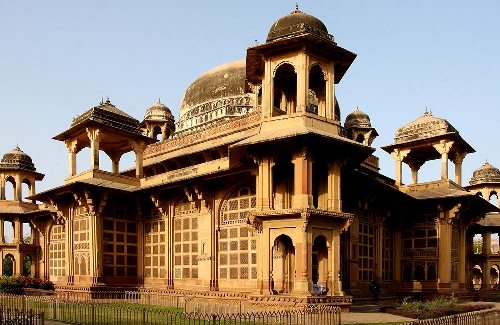
12. Tomb of Tansen, Gwalior
Walk a few steps from the Tomb of Muhammad Ghaus, and you will see a smaller, simpler memorial of Tansen. He was the renowned singer in Akbar’s kingdom and the father of Indian classical music. A national-level music festival is organized every year at his tomb in November-December.
- Timings: 06:00 am – 06:00 pm
- Entry Fee: Free
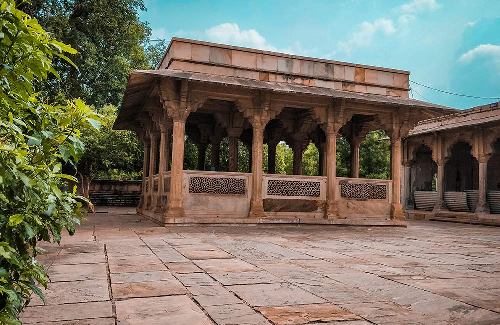
13. Sun Temple, Gwalior
Also called Surya Mandir, Sun Temple is another pride of Gwalior. It was built in 1988 and its design is inspired by the Sun Temple of Konark. Its exteriors are made of red sandstone, making the temple a picture-perfect spot for morning and evening photo shoots. The sculptures inside the temple are carved out of white marble. The temple receives several tourists and pilgrims throughout the year.
- Timings: 06:30 am – 12:00 pm; 01:00 pm – 06:00 pm
- Entry Fee: Free
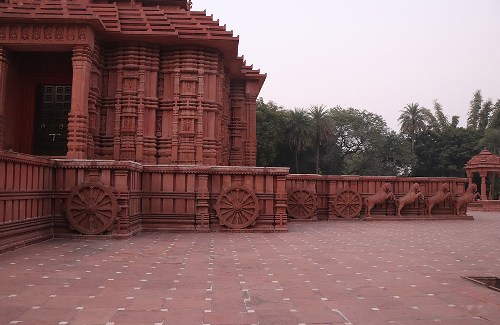
14. Sarod Ghar, Gwalior
Sarod Ghar is a music museum showcasing ancient musical instruments that were once used by the legendary musicians of India. In addition, you will also see a collection of age-old photographs and documents related to music meet-ups in the bygone era. The museum is set up inside the house of legendary sarod player Ustad Hafiz Ali Khan.
- Timings: 10:00 am – 06:00 pm (Closed on Sunday)
- Entry Fee: ₹ 20 for Indians, ₹ 100 for Foreign Tourists
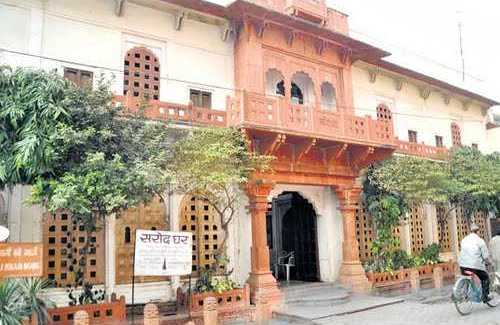
15. Sas-Bahu Temple, Gwalior
Located inside the Gwalior Fort, the Sas-Bahu Temple has two ornately carved temples made in red sandstone. The larger one is devoted to Lord Vishnu and the smaller one to Lord Shiva. Unlike what the name suggests, this temple is actually named after sahastrabahu, another name of Lord Vishnu. King Mahipala of Kacchapaghata Dynasty constructed this temple in the 11th century.
- Timings: 08:00 am – 05:00 pm
- Entry Fee: Free
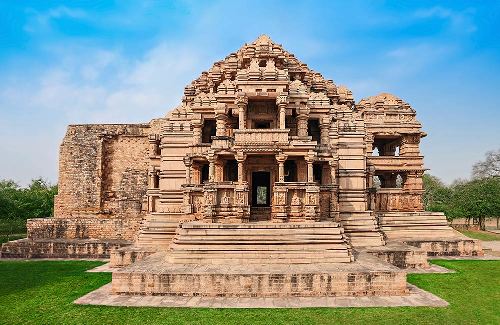
16. Gopachal Parvat, Gwalior
Another popular structure inside the Gwalior Fort, Gopachal Parvat is an ideal place for those who want to see ages-old Jain iconography. It is the site of a group of rock-cut sculptures with carvings dating back to 7th to 15th centuries. The Tirthankaras can be seen meditating in a seated or standing position here. It is one of the most important sites in Gwalior for the followers of Jainism.
- Timings: 24 hours
- Entry Fee: Free
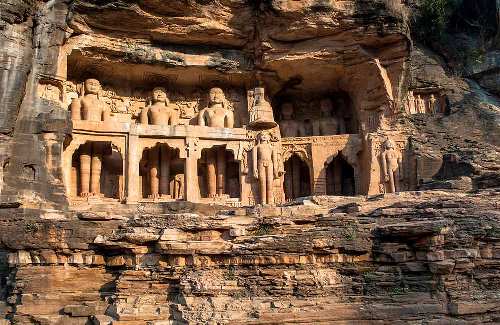
17. Man Mandir Palace, Gwalior
Man Singh Tomar of Tomar Dynasty built the Man Mandir Palace, situated inside the majestic fort in the city. The four-storied palace has many beautiful carvings and designs that exhibit the splendor of Rajputana architecture. The palace also has a Jauhar pond, where Rajput women performed the Sati tradition.
- Timings: 10:00 am – 05:00 pm
- Entry Fee: Free

18. Tigra Dam, Gwalior
Built on Sank River, Tigra Dam is a freshwater reservoir and a major source of water for Gwalior city. It is also a popular picnic spot, where one can enjoy speed boating, paddle boating as well as water scooter rides. If you are looking for a peaceful spot that is a little far from the city, we recommend Tigra Dam.
- Timings: 09:00 am – 05:00 pm
- Distance from Gwalior: 23 km
- Boating Cost: ₹ 50 per person for speed and Jalpari boats; ₹ 100 per person for paddle boat; ₹ 350 per person for water scooter
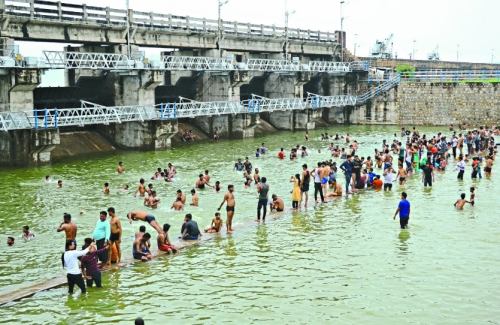
Frequently Asked Questions About Gwalior:
Q: Suggest some good places to eat in Gwalior.
A: Hungry Birds, Shere Punjab, Param Food Complex, Indian Coffee House, Boulevard 69, Silver Saloon, Alfanzo, Victorian Vantage, Cafe Prizon and Kwality are a few of the best restaurants in Gwalior.
Q: How is the air connectivity to Gwalior?
A: Gwalior Airport does have some scheduled domestic flights to and from Delhi, Mumbai, Jabalpur, Bhopal and Indore; however, they do not operate on a daily basis.
Q: What is the best means to reach Gwalior?
A: It is quite easy to reach Gwalior by train from most major cities in India including Delhi, Bhopal, Chandigarh, Ahmedabad, Mumbai, Bangalore, Hyderabad, Chennai, Patna, Kolkata, etc. You can also choose to drive to the city as it is well-connected by national highways like NH 3, NH 75 and NH 92.
Q: How is the public transportation in Gwalior?
A: Tempos, autos, buses and taxis are all easily available from anywhere and everywhere to get around Gwalior.
Q: What are the entry timings and charges of Gwalior Fort?
A: Gwalior Fort remains open to tourists from 6 am to 5.30 pm. The entry fee of Gwalior Fort is INR 75 for Indians and INR 250 for foreigners. For kids below 15 years, the entry is free.
Q: Where to go for shopping in Gwalior?
A: Start your shopping spree at Sarafa Bazaar that has shops stocked with lacquer work, handmade carpets and carved metal storage boxes. Other places to shop in Gwalior include Patankar Bazaar and Bada Market for Chanderi and Maheshwari sarees and printed textiles and Topi Bazaar for baubles and bangles.

